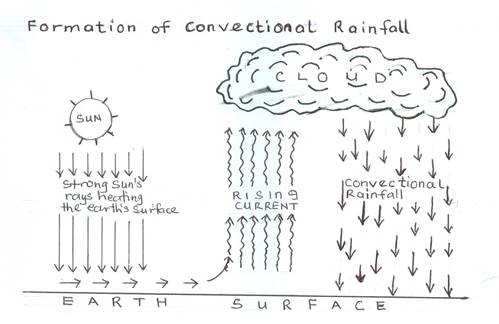Question 6
- Define precipitation.
- With the aid of a diagram, describe the mode of formation of convectional rainfall.
- Explain two effects of temperature on winds.
Observation
This question was fairly popular among the candidates. They were able to define precipitation as the falling of water droplets and ice particles from the clouds to the surface of the earth in the form of rain, snow, hail, dew, etc,
Some of the candidates were not able to draw the diagram that would enable them to explain the formation of convectional rainfall. The expected diagram is illustrated below.

- occurs in the tropics
- the ground is heated by the sun rays
- the surface of the earth is heated by radiation
- air in contact with the earth’s surface is heated by conduction
- it expands, becomes light and rises
- as it rises into cooler altitude, the vapour condenses
- when dew point is reached, the condensed vapour forms cumulo-nimbus cloud
- the water droplets coalesce and become too heavy to be suspended in the cloud
- they fall down to the surface of earth as heavy rainfall
- the water vapour condenses and forms thick cumulo-nimbus clouds
- the torrential downpour is accompanied by thunder and lightning
- this occurs in day time in the tropics and in summer in the temperate regions.
- the rainfall is of short duration
- the sky becomes clear immediately after
Effects of temperature on winds:
- wind direction is determined by temperature differences which creates low and high pressure cells
- wind speed is determined by differences in temperature which creates pressure gradient
- winds blowing from cold environments are influenced by the coldness of the environment
- winds blowing from warm environments are influenced by the warmth that characterize the area
- cold temperatures produce dense air masses which move to take the place of rising air
- warm temperatures produce ascending air currents (winds)
- low temperatures produce high pressure belts from which winds originate
